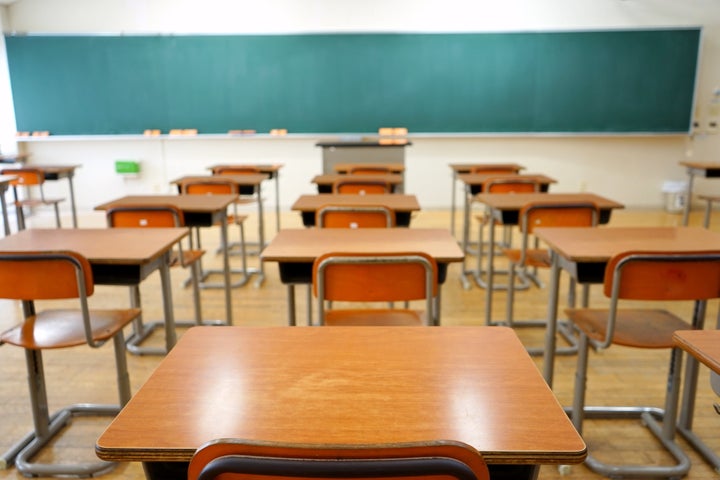
In America, the most rigorous classes, experienced teachers and moderate discipline practices tend to be reserved for white students, according to new survey results from the U.S. Department of Education.
The Department of Education's Civil Rights Data Collection surveys 99 percent of the nation's public schools on issues related to the level of opportunity provided to their students. The survey, which is conducted every other school year, collects data about students' access to classes, teachers and school discipline trends. The latest survey, which has data from the 2013-2014 school year, also collected data on issues like student absenteeism and the quality of education provided in juvenile justice facilities.
The Department of Education provided reporters with top-level national indicators and will release full data that informed its conclusions later in the week.
The survey results paint a picture of vast educational inequalities based on students' skin color and disability status, with only a few bright spots. Specifically, while student suspension rates appear to have dropped 20 percent since the last time data was collected in 2011-2012, stark racial inequities persist in terms of which students receive this punishment.
"In general, the data shows students of color, students whose first language is not English, and students with disabilities are, according to a number of indicators, not getting the same the opportunities to learn as their classmates who are white, first language is English or who do not have disabilities," U.S. Secretary of Education John King Jr. said on a call with reporters Monday.
King is hopeful that the nation's new federal education law, The Every Student Succeeds Act, will serve to rectify some of these inequities.
"These statistics are not just numbers. They represent the educational experiences of real students, whose lives are affected in profound ways by what goes on in their schools," said King.
Even In Preschool, Black Students Are Punished More Harshly Than White Students

As early as preschool, students of color are subjected to harsher punishments than their white peers. The 2011-2012 Civil Rights Data Collection first reported this imbalance -- finding that even though black children accounted for only 18 percent of preschool students, they represented 48 percent of children receiving one or more out-of-school suspensions. Several years later, little has changed. In 2013-2014, black children accounted for 19 percent of preschool students, but 47 percent of students receiving one or more suspensions -- making them 3.6 times more likely to receive a suspension than their white peers.
For K-12 students, this trend continues. Even though the 2.8 million K-12 students who received one or more out-of-school suspensions in 2013-2014 represents a 20 percent decrease from 2011-2013 -- a decline the Education Department is highlighting -- the racial gaps in who gets suspended persist. Black students are 3.8 times more likely to face suspension than white students. Also more likely to receive a suspension are Latino, American Indian and Alaskan Native, Native Hawaiian and Pacific Islander students; mixed-race males; and students with disabilities.
As far as female students go, though, only black girls are being disproportionately suspended.
"The overall reduction in suspension is gratifying," said Catherine Lhamon, the assistant secretary for the Office of Civil Rights, on a call with reporters. She called the persisting racial inequities "not surprising but dismaying ... That is the hardest nut to crack; it is something we are seeing our schools aggressively working on."
Black students are also significantly more likely to be referred to law enforcement or arrested at school. This may be due, in part, to the fact that their schools are more likely to have a school-based police officer. While 42 percent of high schools have a sworn law enforcement officer, this number increases to 51 percent if the student body is composed primarily of black and Latino students, according to the survey. In fact, 1.6 million students nationwide have a police officer in their school but lack a school counselor.
In recent months, schools have faced heightened scrutiny over the presence of law enforcement officers in school, after several high-profile instances of such officers abusing students.
"I don’t think there's any way you could look at this data and not come away with a tremendous sense of urgency about continuing to close our equity gaps," said King.
Millions Of Students Are Chronically Absent From School
Thirteen percent of all U.S. public school students miss 15 or more days of school, the survey found. This adds up to more than 6.5 million students.
"Even the best teacher can't be successful if students aren’t in class," said King about the numbers.
Chronic absenteeism also disproportionately affects students of color, students with disabilities and English-language learners. In 2015, the Department of Education launched an initiative -- Every Student, Every Day: A National Initiative to Address and Eliminate Chronic Absenteeism -- to address some of these issues.
“I don’t think there's any way you could look at this data and not come away with a tremendous sense of urgency.”
- John King, U.S. Secretary of Education
Only Some Students Get Experienced Teachers
Not only are students of color more likely to face disproportionately harsh discipline practices and high rates of police in schools, they also get less access to experienced teachers and rigorous courses.
Eleven percent of black students and 9 percent of Latino students attend schools where more than a fifth of educators are in their first year of teaching. Only 5 percent of white students face the same situation.
On top of that, black and Latino students are less likely to attend schools where high-level math and science courses are offered, the survey found.
"Our systemic failure to educate some groups of children as well as others tears at the moral fabric of the nation," said King.
______
Rebecca Klein covers the challenges faced in school discipline, school segregation and the achievement gap in K-12 education. In particular, she is drilling down into the programs and innovations that are trying to solve these problems. Tips? Email Rebecca.Klein@huffingtonpost.com.
______
Related Stories:
